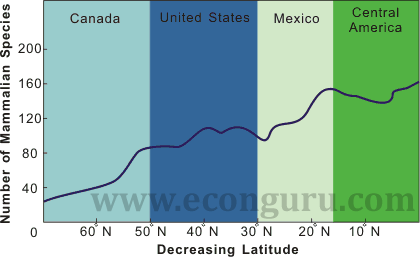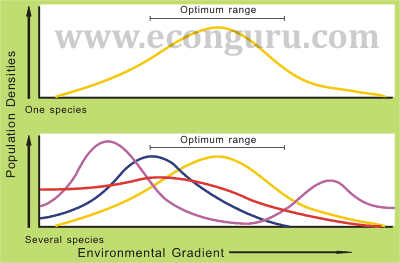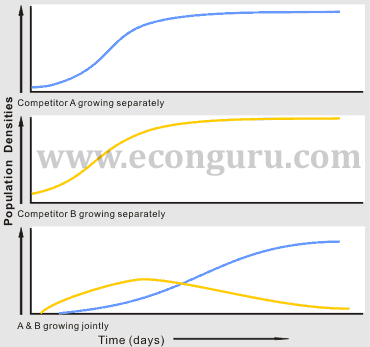| info.html, history.html, glossary.html | |
|
Translate: French | German | Italian | Japanese | Spanish | Portuguese |
|
Of EconGuru |
Back to Previous Page |
Fundamentals of Ecology
Ecological Community
| « Chapter 2 | Contents | Chapter 4 » |
3. Community
A community is comprised of all the various populations interacting in a area. An example of a community is a coral reef where numerous populations of fishes, crustacea and corals exist and interact. Ecologists try to know at this level how different relationships like predation and competition are influencing the organization and evolution of a community.
3.1. Composition and Diversity
Communities distinguish from each other by two characteristics: composition and diversity. The composition of a community is simply a listing of the various species in the community. The diversity digs deeper than mere composition in that it involves both species richness(the number of species) as well as evenness (the relative abundance of different species).
Community Diversity over Decreasing Latitude

One of the straightforward model regarding community composition and diversity, is the individualistic model. According to the individualistic hypothesis, each species is distributed along environmental gradients(the gradients of various abiotic factors, e.g. moisture, temperature and inorganic nutrients available) as long as they are within its tolerance. And a community is thus formed as an assemblage of species that happen to occupy the same area because of similar tolerances. Refer to the graphs below.
Community Individualistic Model

However, other models exist such as interactive model to explain community and most ecologists supported it for many years, because it bases its hypothesis not only on species' responses to abiotic factors but also biotic factors. Search the web if you want to learn more about it.
3.2. Habitat and Ecological Niche
Just as Elton John sings the Circle of Life, each species play its role in a community, eat or be eaten, live or let live. They occupy particular positions both in a spatial sense(where to live) and a functional sense(what is the part). A habitat is an environment wherein an organism lives and reproduces, while the ecological niche is the functional role the organism plays in its community, including its habitat as well as the interactions with other organisms. Niche includes everything(e.g. resources an organism needs to meet its energy, nutrient, and survival demands) and every aspects of the way(e.g. the environmental features it needs to hunt and to escape successfully) an organism live with the environment, since it's difficult to delve into one niche completely, most observations concentrate on certain aspects of it.
Since an organism's niche is affected by abiotic factors(such as climate and habitat) and biotic factors(such as competitors, parasites, and predators) simultaneously, usually two types of niches are looked at separately by ecologist, the fundamental niches and the realized niches. The fundamental niche of an organism comprises all conditions whereunder it can potentially survive and reproduce; the realized niche is the set of conditions whereunder it exists in nature.
3.3. Interactions
Competition for resources, predator-prey, parasite-host, and other types of interactions integrate species into a system of dynamic interacting populations.
| Type of Interaction | Expected Outcome | |
|---|---|---|
| Competition | - - | Decrease in both species |
| Predation | + - | Predator increases, prey decreases |
| Symbiotic Relationships | ||
| Parasitism | + - | Parasite increases, host decreases |
| Commensalism | + 0 | One increases, the other not affected |
| Mutualism | + + | Increase in both species |
As indicated in the above table, competition for limited resources between two species has a negative effect on the population abundances of both species. In predation and parasitism, the abundances of predator and parasite are expected to increase at the expense of that of prey and host, since predators feed on prey and parasites obtain nutrients from the host. In commensalism one species is benefited whereas the other is not harmed. In mutualism, two species help one another and both species are benefited.
3.3.1. Competition among Populations
Interspecific competition occurs when members of different species try to utilize the same resource like light, space, or nutrients that is in limited supply, or when their niches overlap. If it is unlimited, no competition would have been triggered. Competition leads to several possible outcomes. One of them is the extinction of one of the competitors. The following graphs depict this pattern.
Compete to Extinction

You might wonder, now that competitions lead to extinctions, why the world is still filled with myriads of living things that share the resources. Good question, but you are partly right, and partly wrong. Extinction is not the only result of competition, two species can both survive the competition, but they have to change, or more technically, their niches have to adapt. In the light of competitive exclusion principle that no two species can concurrently occupy the same niche, either one of the species die out or both shift their niches. One of the embodiment of niche shift, or niche partitioning is resource partitioning. Resource partitioning decreases competition between two species, and it is more observable than other subtle forms of niche partitioning.
Example of Resource Partitioning
When three species of ground finches of the Galapagos Islands occur on isolated islands, their bills tend to be the same intermediate size, enabling them to feed on a wider rage of seeds. Where they co-occur, selection has favored divergence in beak size because the size of the beak affects the kinds of seeds that can be eaten. In other words, competition has led to resource partitioning.
The tendency for characteristics to be more divergent when populations belong to the same community than when they live separately is termed character displacement. And it is often used as evidence for that competition and resource partitioning have taken place.
3.3.2. Predator-Prey Interactions
In predation, one organism, called the predator feeds on another, called the prey. With common sense, there should be no dispute on that the relationship between lion and zebra is that of predation. But what is the relationship that herbivorous deer feeds on trees and bushes? This might be a little bit surprising, but in a broader sense, predaceous consumers include not only animals but also herbivores that feed on plants.
By observation, we have revealed the interacting pattern between the populations of predator and prey, cycles of fluctuation that one drives the other and vice versa. Population of the prey increases as that of the predator decreases, since fewer prey are being eaten. At the carrying capacity of the environment, the number of prey reaches its summit and stops growing. The predators now are provided with plenty of prey to feed on, so the population increases as that of prey decreases. Again, the predators' increased number overconsume the prey, as the prey population declines, so does the prey population. See the graph below.
Predator-Prey Population Dynamics

Most predator-prey population cycles are like what we have discussed, probably with more elaboration of the dynamics and curves. However, their interactions involve more than just population cycles, other behaviors like prey defenses might also interest you. If so, do check the picked links below.
3.3.3. Symbiotic Relationships
A symbiotic relationship, or symbiosis is one in which members of two populations interact very closely. As indicated by the table in section 3.3, three types of symbiotic relationships exist and by the way at least one species benefit from such a relationship while the other is harmed or unaffected or benefited.
Parasitism resembles predation in that an organism called a parasite derives nourishment from another called the host(just as the predator derives nourishment from its prey), though parasites also take hosts as habitats and springboards to transmit themselves to other hosts. Parasites appear in all kingdoms of life. Some of the frequently heard of parasites include viruses(e.g., HIV), bacteria(e.g., strep infection), protists(e.g., malaria), fungi(e.g., rusts and smuts), plants(e.g., mistletoe), and animals(e.g., leeches).
Commensalism is a symbiotic relationship wherein one species is benefited and the other is neither benefited or harmed. Well known instances are those in which one species provides a habitat or a means of transportation for the other.
Example of Commensalism
Animalia: Barnacles attach themselves to the backs of whales and the shells of horseshoe crabs to get a free home and ticket for transportation. Remoras are fishes that attach themselves to the bellies of sharks by means of modified dorsal fin acting as a suction cup.
Plantae: Epiphytes grow in branches of tree in order to receiver light, but not to take nourishment from the trees. Instead, their roots obtain nutrients and water from the air.
Mutualism is a symbiotic relationship in which both species benefit. In many cases, mutualistic relationships help organisms obtain food or avoid predation. As with parasitism, it's possible to find examples of mutualism in all kingdoms.
Example of Mutualism
Human & Bacteria: Human cannot synthesize vitamins by themselves, but can benefit from some bacteria residing in their intestinal tract that make vitamins. Meanwhile, bacteria are provided with food.
Termites & Protozoa: Termites rely on the protozoa in their intestinal tract to digest wood.
To sum up, symbiotic relationships do occur between species, but the three patterns we provided may be too simple to embrace all the natural forms of symbiosis. We were just skimming roughly. Many other derivative forms of symbiosis are developed, look for other materials if you are interested.
| « Chapter 2 | Contents | Chapter 4 » |
Of EconGuru |
Back to Previous Page |